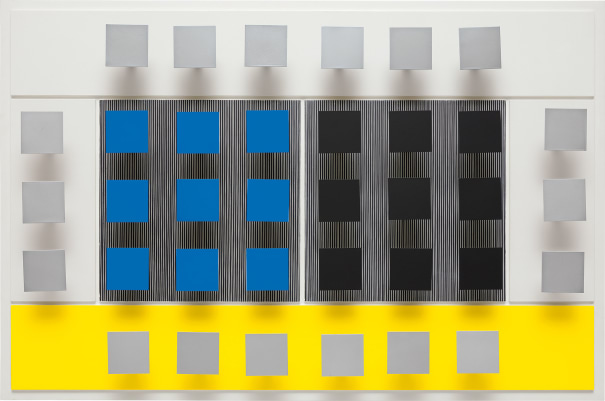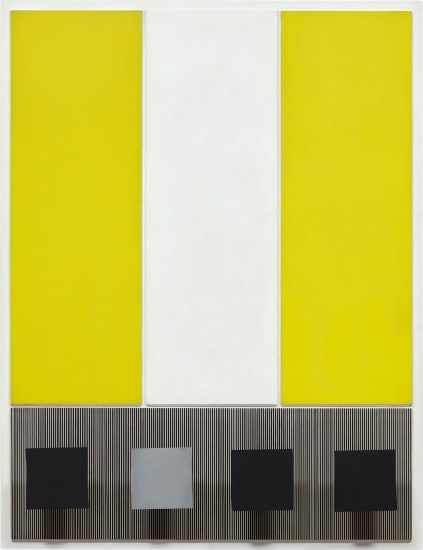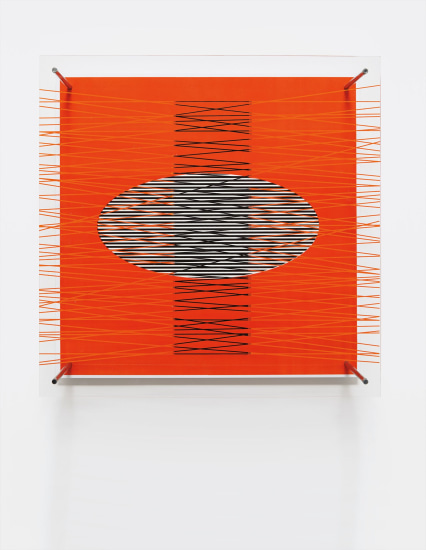VENEZUELA Jesús Rafael Soto Oro y Plata 1969 oil on wood, nylon and metal 57 1/2 x 42 1/8 x 7 1/8 in. (146 x 107 x 18 cm.) Signed, titled and dated "'Oro y Plata' Soto 1969" on the reverse. This work is accompanied by a certificate of authenticity issued by Atelier Soto.
Provenance Atelier Soto, Paris Acquired from the above by the present owner Exhibited São Paulo, Galeria Raquel Arnaud, Em Movimento, 16 August- 19 October, 2013 Catalogue Essay I am interested in the way we live. We live like a fish in water because all our circumstances and movements are conditioned by a very fluid medium, perhaps initiated by way of the Big Bang. I don’t know. It is this medium that initiates the presence of constructive elements. Jesús Rafael Soto 2001 A pioneer of Kinetic Art and Op Art, Venezuelan artist Jesús Rafael Soto has produced since the 1950s a body of work that is remarkable for its ability to consistently examine complex philosophical and scientific questions pertaining to the nature of the universe. At the same time, Soto’s works have powerfully expanded art’s possibilities by redefining art’s relationship to viewers. Refusing a traditional model of passive contemplation, Soto’s reliefs and sculptures require the active participation of the viewer, who must, in the case of his reliefs, circulate before the work in a lateral back and forth, or, in the case of his later interactive sculptures, the Penetrables, actually penetrate the work itself to touch and even play with it. Soto began his career in Venezuela, where he obtained a scholarship to study at the Escuela de Artes Plásticas of Caracas. He fraternized with some of Venezuela’s most important postwar artists—Mercedes Pardo, Carlos Cruz Diez and Alejandro Otero to name a few—and gained a thorough understanding of Impressionism and Cubism, movements that the artist always regarded as fundamental to his artistic practice. “For me,” the artist confessed, “Cubism was an exercise in construction, in the ordering of planes, a tool that helped me to translate the tropical light.” And indeed, it was Soto’s lifelong interest in this tropical light—an interest that is characteristic of many great Venezuelan modern artists, such as Armando Reverón and Carlos Cruz-Diez—that fully manifests itself in Oro y Plata. The shimmering surface of this relief’s gold and silver backdrop creates a subtle play with light that is evocative of Venezuela’s tropical vistas. Soto’s embrace of gold and silver functions as a reference to the legendary natural wealth of Latin America. The imposing verticality of two large rectangles separated by a central line might recall the zip paintings of Barnett Newman But as sleek and modern as they look, these two metallic planes nevertheless remain tied to a Latin American context. A perfect blend of the pre-modern and modern, they double as Soto’s subtle references to illusions of the past, as for example, the Spanish conquistadores’ quest for the mythical city of El Dorado. Yet as much as Oro y Plata is tied to a Latin American vision, it is also the result of Soto’s rapid integration in the avant-garde art circles of Paris. After his successful career debut in Venezuela, where he directed the Escuela de Bellas Artes in Maracaibo, Soto traveled to Paris on a grant and began frequenting the highly experimental Salon des Realités Nouvelles and Galerie Denise René. He exchanged ideas with well-known European artists like Fernand Léger Jean Arp, Jean Tinguely Victor Vasarely and also befriended important Latin American artists, who like him, would become central players in the development of kinetic and interactive art in Paris. It is at this point that Soto began experimenting with optics and movement. As can be seen in Oro y Plata, Soto seeks to engage the viewer, not as a disembodied eye looking at the work from a fixed position, but as a physical subject moving about the space in which the work is placed. In this work, three rods hang before an incandescent background that makes the visual apprehension of these rods an interactive experience. The background’s lower left section is striated by thin lines that results in an optical flickering or moiré effect activated whenever the viewer changes position. As a result, the
VENEZUELA Jesús Rafael Soto Oro y Plata 1969 oil on wood, nylon and metal 57 1/2 x 42 1/8 x 7 1/8 in. (146 x 107 x 18 cm.) Signed, titled and dated "'Oro y Plata' Soto 1969" on the reverse. This work is accompanied by a certificate of authenticity issued by Atelier Soto.
Provenance Atelier Soto, Paris Acquired from the above by the present owner Exhibited São Paulo, Galeria Raquel Arnaud, Em Movimento, 16 August- 19 October, 2013 Catalogue Essay I am interested in the way we live. We live like a fish in water because all our circumstances and movements are conditioned by a very fluid medium, perhaps initiated by way of the Big Bang. I don’t know. It is this medium that initiates the presence of constructive elements. Jesús Rafael Soto 2001 A pioneer of Kinetic Art and Op Art, Venezuelan artist Jesús Rafael Soto has produced since the 1950s a body of work that is remarkable for its ability to consistently examine complex philosophical and scientific questions pertaining to the nature of the universe. At the same time, Soto’s works have powerfully expanded art’s possibilities by redefining art’s relationship to viewers. Refusing a traditional model of passive contemplation, Soto’s reliefs and sculptures require the active participation of the viewer, who must, in the case of his reliefs, circulate before the work in a lateral back and forth, or, in the case of his later interactive sculptures, the Penetrables, actually penetrate the work itself to touch and even play with it. Soto began his career in Venezuela, where he obtained a scholarship to study at the Escuela de Artes Plásticas of Caracas. He fraternized with some of Venezuela’s most important postwar artists—Mercedes Pardo, Carlos Cruz Diez and Alejandro Otero to name a few—and gained a thorough understanding of Impressionism and Cubism, movements that the artist always regarded as fundamental to his artistic practice. “For me,” the artist confessed, “Cubism was an exercise in construction, in the ordering of planes, a tool that helped me to translate the tropical light.” And indeed, it was Soto’s lifelong interest in this tropical light—an interest that is characteristic of many great Venezuelan modern artists, such as Armando Reverón and Carlos Cruz-Diez—that fully manifests itself in Oro y Plata. The shimmering surface of this relief’s gold and silver backdrop creates a subtle play with light that is evocative of Venezuela’s tropical vistas. Soto’s embrace of gold and silver functions as a reference to the legendary natural wealth of Latin America. The imposing verticality of two large rectangles separated by a central line might recall the zip paintings of Barnett Newman But as sleek and modern as they look, these two metallic planes nevertheless remain tied to a Latin American context. A perfect blend of the pre-modern and modern, they double as Soto’s subtle references to illusions of the past, as for example, the Spanish conquistadores’ quest for the mythical city of El Dorado. Yet as much as Oro y Plata is tied to a Latin American vision, it is also the result of Soto’s rapid integration in the avant-garde art circles of Paris. After his successful career debut in Venezuela, where he directed the Escuela de Bellas Artes in Maracaibo, Soto traveled to Paris on a grant and began frequenting the highly experimental Salon des Realités Nouvelles and Galerie Denise René. He exchanged ideas with well-known European artists like Fernand Léger Jean Arp, Jean Tinguely Victor Vasarely and also befriended important Latin American artists, who like him, would become central players in the development of kinetic and interactive art in Paris. It is at this point that Soto began experimenting with optics and movement. As can be seen in Oro y Plata, Soto seeks to engage the viewer, not as a disembodied eye looking at the work from a fixed position, but as a physical subject moving about the space in which the work is placed. In this work, three rods hang before an incandescent background that makes the visual apprehension of these rods an interactive experience. The background’s lower left section is striated by thin lines that results in an optical flickering or moiré effect activated whenever the viewer changes position. As a result, the











Try LotSearch and its premium features for 7 days - without any costs!
Be notified automatically about new items in upcoming auctions.
Create an alert